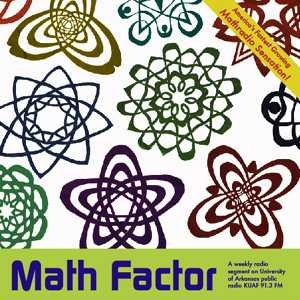
Episode 20: Calculus and fluid dynamics
05/22/15 • -1 min
This week the topic was calculus and differentiation. We talked to Florencia Tettamanti, who’s a mathematician working on fluid dynamics. We talked about how Flo uses calculus to study the motion of fluids like air and water, and what it’s like to be a research mathematician.
Interesting links:
- Basic differentiation, at s-cool
- Differential equations, at the University of Surrey website
- Fluid dynamics on Wikipedia
- NSF videos on Fluid Mechanics - YouTube playlist
Puzzle: If your function is given by y = x2 - 6x + 13, what is the minimum value of y, and for which value of x does the function give this value?
Solution:
If you plot the points x=1, x=2, x=3 and x=4 you can clearly see the curve of this graph and that it seems to have a maximum at x=3, for which the value of y is 4. To see what the graph looks like, you can input the equation into Wolfram Alpha.
Another way to see this is to rearrange the equation: x2-6x+13 = (x-3)2+4, and by examining this equation we can see that this is just an x graph, shifted across by 3 and up by 4, so its turning point and hence the minimum will be at x=3 and y=4.
If you know how to use calculus, you can find the turning point more easily - if you differentiate x2-6x+13 you get 2x - 6, which will equal zero when x=3, and putting this value back into the original equation gives y=4.
Show/HideThis week the topic was calculus and differentiation. We talked to Florencia Tettamanti, who’s a mathematician working on fluid dynamics. We talked about how Flo uses calculus to study the motion of fluids like air and water, and what it’s like to be a research mathematician.
Interesting links:
- Basic differentiation, at s-cool
- Differential equations, at the University of Surrey website
- Fluid dynamics on Wikipedia
- NSF videos on Fluid Mechanics - YouTube playlist
Puzzle: If your function is given by y = x2 - 6x + 13, what is the minimum value of y, and for which value of x does the function give this value?
Solution:
If you plot the points x=1, x=2, x=3 and x=4 you can clearly see the curve of this graph and that it seems to have a maximum at x=3, for which the value of y is 4. To see what the graph looks like, you can input the equation into Wolfram Alpha.
Another way to see this is to rearrange the equation: x2-6x+13 = (x-3)2+4, and by examining this equation we can see that this is just an x graph, shifted across by 3 and up by 4, so its turning point and hence the minimum will be at x=3 and y=4.
If you know how to use calculus, you can find the turning point more easily - if you differentiate x2-6x+13 you get 2x - 6, which will equal zero when x=3, and putting this value back into the original equation gives y=4.
Show/HidePrevious Episode

Episode 19: Computer games and mechanics
This week the topic was mechanics and friction. We interviewed Dan Hett, who works for CBBC writing computer games for their website. We talked about his work and how he uses a lot of mathematics in modelling how characters move, and making sure that’s done in a realistic way.
Interesting links:
- CBBC games website
- CBeebies story app (with pop-up book!)
- Game physics on Wikipedia
- A-level Mechanics topics at MathsRevision.net
- Friction and Coefficients of Friction at Engineering Toolbox (with some example values)
- Coefficient of friction on Wikipedia
Puzzle: Susan the Hedgehog runs at 20cm/s across the screen while the run button is held down. Once the run button is released, she slows down with constant deceleration of 8.5cm/s2. Will she stop within 32cm more of screen?
Solution:
The time taken to stop can be calculated by knowing that every second travelled, 8.5cm/s of speed is lost, so after 20/8.5=2.35 seconds, speed will be zero. We can approximate this deceleration by imagining Susan is travelling at 20cm/s for 1 second, 11.5cm/s for 1 second and 3cm/s for the remaining 0.35 seconds until she stops. This will cover more distance than the actual motion does (as your speed is lower than this for most of the time), but will cause you to travel only 31.6cm - so you will definitely stop within 32cm. (In actual fact, the distance taken to stop will be 23.53cm, because your speed continues to decrease at a constant rate for the whole time. In order to work this out, you need to use a little calculus!) Show/HideIf you like this episode you’ll love
Episode Comments
Generate a badge
Get a badge for your website that links back to this episode
<a href="https://goodpods.com/podcasts/taking-maths-further-podcast-104509/episode-20-calculus-and-fluid-dynamics-5456813"> <img src="https://storage.googleapis.com/goodpods-images-bucket/badges/generic-badge-1.svg" alt="listen to episode 20: calculus and fluid dynamics on goodpods" style="width: 225px" /> </a>
Copy




